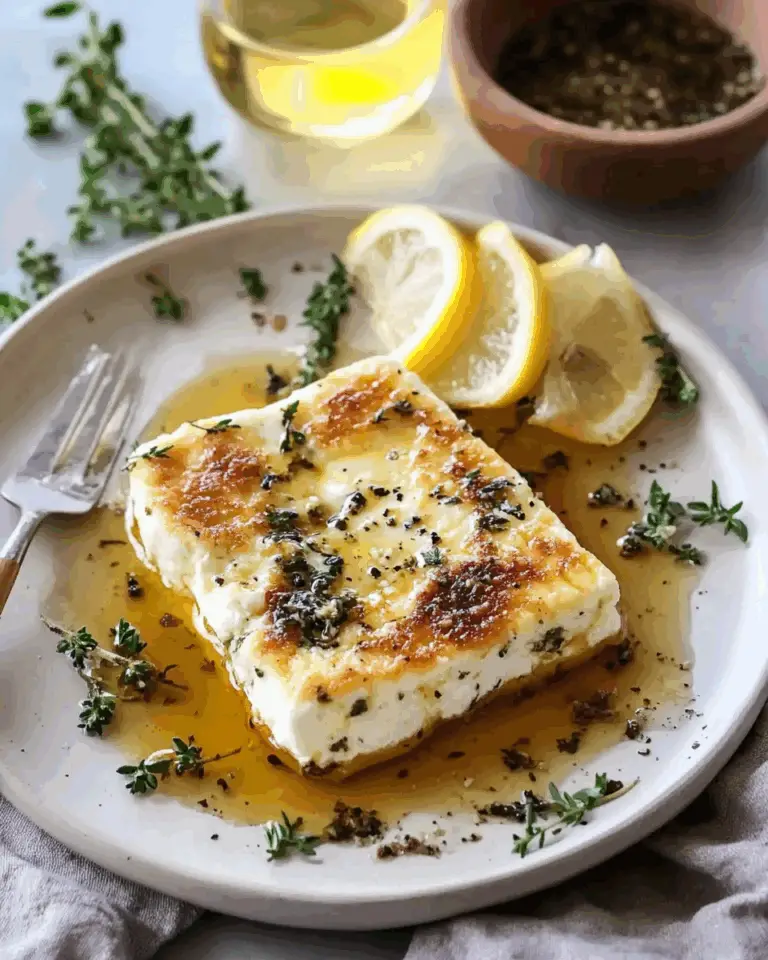Feta Saganaki is a delicious Greek appetizer featuring warm, melted feta cheese fried to golden perfection. Crispy on the outside and creamy inside, this simple dish is flavored with olive oil, lemon, and herbs, making it an irresistible starter or snack that pairs wonderfully with crusty bread or fresh vegetables.
Full Recipe:
Ingredients
-
8 ounces block of feta cheese
-
2 tablespoons olive oil
-
1 teaspoon dried oregano
-
1 tablespoon fresh lemon juice
-
Freshly ground black pepper, to taste
-
Lemon wedges, for serving
-
Fresh parsley, chopped (optional)
Directions
-
Heat olive oil in a small skillet over medium heat.
-
Place the block of feta cheese in the skillet and cook for about 2-3 minutes until the bottom is golden brown and crispy.
-
Carefully flip the feta and cook the other side for another 2 minutes until golden.
-
Sprinkle dried oregano and freshly ground black pepper over the cheese.
-
Remove from heat, drizzle with lemon juice, and garnish with chopped parsley if desired.
-
Serve immediately with lemon wedges and crusty bread or veggies for dipping.
Nutrients
-
Calories: Approximately 200 kcal per serving
-
Protein: 10 g
-
Fat: 18 g
-
Carbohydrates: 1 g
Flavor Profile and Ingredient Harmony
The magic of feta saganaki lies in its contrasting textures and vibrant flavors. The feta cheese, when heated, transforms from a firm, crumbly block into a molten, creamy center encased in a crunchy golden crust. This textural contrast enhances the eating experience, providing a satisfying crispness that gives way to the cheese’s rich, tangy creaminess.
Olive oil plays a dual role: it crisps the feta’s exterior to perfection and adds a fruity, peppery note that complements the cheese’s briny sharpness. The addition of dried oregano, a staple herb in Greek cuisine, introduces earthy, slightly bitter tones that balance the richness of the cheese.
Fresh lemon juice brightens the dish with a burst of acidity, cutting through the feta’s creaminess and elevating its natural tang. The sprinkle of freshly ground black pepper adds a gentle heat and complexity without overpowering the delicate balance.
The optional garnish of fresh parsley adds a hint of herbal freshness and color contrast, completing this simple yet elegant appetizer. Each component works harmoniously to celebrate the distinct character of feta cheese while enhancing its appeal with complementary flavors.
Cultural Significance and Culinary Tradition
Feta saganaki holds a special place in Greek cuisine and culture. Saganaki refers broadly to foods cooked in a small frying pan, and frying cheese in this manner is a traditional method cherished across Greece. This preparation exemplifies the Mediterranean diet’s focus on fresh, wholesome ingredients prepared in uncomplicated ways that highlight their natural flavors.
Feta cheese, made from sheep’s or goat’s milk, is a protected designation of origin (PDO) product in the European Union, prized for its crumbly texture and tangy taste. Its use in saganaki reflects the Greek emphasis on dairy as a central element in their culinary landscape.
Serving feta saganaki at social gatherings, family meals, or as part of a meze (small plates) spread fosters a spirit of conviviality and shared enjoyment. This dish invites communal eating, where friends and family can savor flavors together while enjoying lively conversation.
Nutritional Insights and Considerations
Feta saganaki is a nutrient-dense appetizer, offering protein and fat primarily from the cheese and olive oil. Protein content supports muscle maintenance and overall bodily functions, while fats provide energy and aid in the absorption of fat-soluble vitamins.
Feta cheese is rich in calcium, essential for bone health, and contains beneficial probiotics that may promote gut health. Olive oil contributes heart-healthy monounsaturated fats and antioxidants, which support cardiovascular wellness and reduce inflammation.
While the dish is relatively high in fat, the fats are predominantly healthy, and moderate consumption can fit well within a balanced diet. Sodium content can be significant due to the saltiness of feta, so it’s advisable for those monitoring salt intake to enjoy this dish in moderation or balance it with lower-sodium meals throughout the day.
With only trace carbohydrates, feta saganaki is suitable for low-carb and ketogenic diets, making it a versatile option for various eating plans.
Preparation Techniques and Tips for Perfection
Achieving the perfect feta saganaki requires attention to heat management and timing. Using a good quality block of feta cheese is essential, as the texture and flavor of the cheese directly affect the dish’s outcome. The cheese should be firm enough to hold its shape during cooking yet melt to a creamy consistency inside.
Heating the olive oil in a small, heavy-bottomed skillet over medium heat ensures even cooking and prevents burning. Placing the feta in the hot oil allows the exterior to develop a golden crust without overcooking the inside. Careful flipping after a few minutes is necessary to brown the other side while maintaining the cheese’s molten center.
Sprinkling oregano and pepper while the feta is still hot helps the flavors adhere and meld with the cheese. Drizzling fresh lemon juice right before serving adds a bright, fresh finish and prevents the cheese from becoming too oily or heavy.
Serving immediately is crucial, as the cheese is at its best warm, with the contrast of textures fully intact. Pairing with crusty bread or crisp vegetables provides complementary textures and makes for an engaging eating experience.
Serving Suggestions and Pairings
Feta saganaki is traditionally served as an appetizer or as part of a meze platter alongside other Greek delights such as olives, tzatziki, grilled vegetables, and pita bread. Its rich, savory profile pairs wonderfully with crunchy, fresh accompaniments that balance its creaminess.
Crusty bread is ideal for dipping into the melted cheese and olive oil, while fresh vegetables like cucumber slices, cherry tomatoes, or radishes offer refreshing, crisp bites. Lemon wedges enhance the flavor further and allow diners to add acidity according to taste.
For beverage pairings, feta saganaki complements dry white wines like Assyrtiko or Sauvignon Blanc, which provide acidity and freshness to counterbalance the cheese’s richness. Light beers or sparkling water with citrus are also excellent choices.
The dish can be incorporated into casual gatherings or more formal dinners, adding a touch of Mediterranean flair and culinary sophistication.
Why Feta Saganaki is a Timeless Favorite
Feta saganaki’s enduring popularity stems from its simplicity, bold flavors, and satisfying textures. It exemplifies the Mediterranean philosophy of using a few quality ingredients to create something greater than the sum of its parts.
The ease of preparation makes it accessible to both novice and experienced cooks, while its elegant presentation makes it a standout on any table. Its combination of crispy crust and creamy interior satisfies a wide range of palates and dietary preferences.
This dish’s adaptability—whether served plain, with herbs, or accompanied by various dips—ensures it remains relevant across different occasions and culinary trends.
Conclusion
Feta Saganaki is a quintessential Greek appetizer that delivers rich, savory flavor and delightful textures with minimal ingredients and effort. The crispy golden exterior contrasts beautifully with the warm, creamy cheese inside, creating an indulgent yet balanced dish. Flavored with olive oil, lemon, and herbs, it captures the essence of Mediterranean simplicity and freshness.
Perfect for sharing with friends and family, feta saganaki elevates any meal or gathering with its rustic elegance and bold taste. Its nutritional benefits and versatility make it a valuable addition to a range of eating plans and occasions.
Including this recipe on your website offers readers an opportunity to experience a beloved Greek classic that celebrates quality ingredients, straightforward preparation, and memorable flavor. It invites home cooks to explore Mediterranean cuisine and enjoy a dish that is as satisfying as it is timeless.






